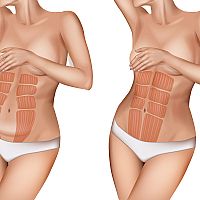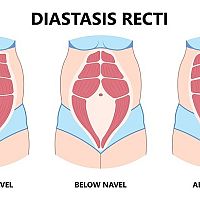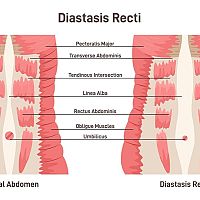
Diastasis Recti in pregnancy and after childbirth. What exercises will help?
Due to the changes a woman's body undergoes during pregnancy, diastasis is considered one of the most common physiological phenomena. Up to 60% of mothers experience diastasis after childbirth, and the degree of severity depends on the condition of the abdominal muscles before pregnancy. The diastasis itself represents a separation of the rectus abdominis muscles - the linea alba - which connects the right and left abdominal muscle tissues. As a result of excessive pressure during pregnancy or after childbirth, the rectus abdominis muscle is stretched, thereby the muscle separates and forms in the middle of the gap. It is even possible to diagnose diastasis by self-examination. Alternatively, it is performed by palpation (touch) by a doctor or physiotherapist. Why does diastasis occur after childbirth? What are the exercises for diastasis?
It is no rarity that a large number of women encounter diastasis after childbirth or pregnancy. In some cases, the symptoms of abdominal diastasis are more pronounced. Some women are lucky enough that the protruding belly (roof) does not cause them a problem, because their muscles have withstood the pressure of the growing uterus and fetus. Exercising during pregnancy is important, because it is precisely the appropriate exercises during pregnancy that can significantly reduce the risk of developing diastasis. They therefore represent an effective prevention and at the same time it is an effective way of solving the condition of stretched abdominal muscles already after childbirth. Stretching of soft structures also occurs during pregnancy as a result of hormonal changes. What is diastasis recti? What is the Tupler method? How to do a self-examination? You can read more in our article.
What is diastasis?
The rectus abdominis is made up of the right and left sides, which are interconnected by ligaments and thus form our abdominal muscles (so-called abs). Both sides are connected by a central ligament line, which is called linea alba. A significant spreading of the abdominal muscles due to the stretching of the central ligamentous structure of the linea alba is referred to as diastasis. Such a stretched abdominal muscle during pregnancy arises as a result of hormonal or physiological changes. However, diastasis can also occur with rapid weight gain (obesity), improper exercise, or it may be the result of another disease. A diastasis is considered a separation of the abdominal muscles by more than 2-2.5 cm.
Diastasis is not only a cosmetic defect, it also causes a certain dysfunction of the abdominal muscles, which significantly weakens the center of the body and limits mobility. One of the most common causes of diastasis in women is pregnancy. This condition occurs most often during pregnancy and can persist for several weeks after childbirth. A genetic predisposition also plays a role in the development of diastasis, which affects the condition of the linea alba ligament itself.
Hormonal changes (hormone relaxin), the growth of the uterus and the fetus cause the soft ligaments and muscle structures to stretch and create a gap between the right and left sides of the abdomen. If this central (core) muscle is not strong enough, the individual sides move away from each other and diastasis occurs. Most often, diastasis during pregnancy appears in women whose abdominal muscles and the middle of the body were already weakened before pregnancy. Abdominal diastasis appears in more than half of women after childbirth. After childbirth, the diastasis is usually gradually alleviated (within 6 to 8 weeks), but the separated abdominal muscles need to be strengthened. It is necessary to solve the separation of the abdominal muscles by exercise (physiotherapy), movement, and in serious cases it is even necessary to proceed with an operative solution.
The worst condition is when the linea alba ruptures due to excessive intra-abdominal pressure. Subsequently, the abdominal wall is exposed and the lower abdomen is covered only with fat and skin. It is possible to feel the stomach or intestines. In such a case, there may be prolapse of the organs of the small pelvis (descent of the organs downwards) or the diastasis is accompanied by an umbilical hernia (band). An operative solution is possible and sometimes required in such cases.
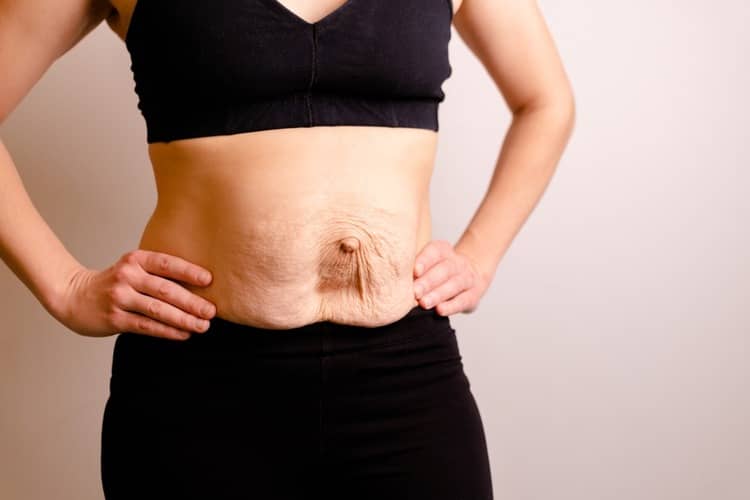
Diastasis in pregnancy - symptoms
What does diastasis look like? Due to the fact that the abdominal muscles are weakened, diastasis is most often manifested by arching, or emergence of the abdominal cavity. The spread of the abdominal muscles weakens the center of the body, which reduces the functionality of the support and movement apparatus. Postpartum diastasis usually resolves within 6 to 7 weeks. Sometimes this process can take longer, because it depends on the extent of the diastasis. Even if the arch is lost, the abdomen is subsequently sagging and flabby, precisely because the abdominal muscles continue to be weakened and spread apart.
Diastasis itself is not painful for a woman. Pain in the abdominal muscles during pregnancy does not necessarily indicate the formation of diastasis. These are often muscle contractions of the uterus (false contractions) or digestive problems. Diastasis represents a cosmetic and functional deficiency. As the abdominal muscles move away from each other, certain physiological changes occur that can be uncomfortable for a woman during pregnancy or after childbirth.
By weakening the muscle structures, the stability of the center of the body deteriorates, back pain appears, and the risk of incontinence increases. There is a risk of prolapse of the organs of the small pelvis, which fall and can cause the mentioned urinary incontinence or disorders of the menstrual cycle (irregularity and pain). When these symptoms are indicated, it is advisable to seek professional help. Problems with digestion also often arise as a result of impaired peristalsis of the intestines.
Significantly weakened abdominal muscles, multiple births, obesity, insufficient physical activity, pregnancy over the age of 35 are considered risk factors for the development of diastasis. overload or mechanical damage to the abdominal muscle tissues.
Did you know that most newborns also suffer from diastasis? This is a very common and natural phenomenon. The abdominal muscles of newborns are not yet sufficiently strong and developed. Thanks to movement and changes in position, the abdominal muscles will be strengthened and the diastasis will usually recede on its own.
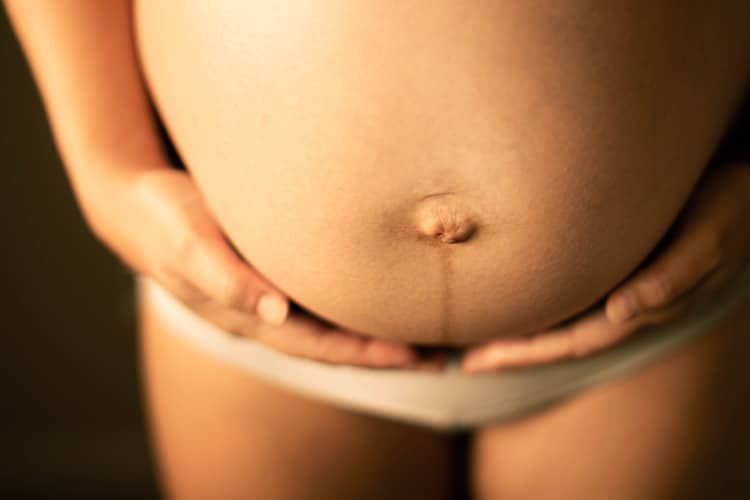
Diagnosis and self-examination of diastasis
Diastasis during pregnancy or after childbirth is not a reason for excessive concern. Most women cope with it very well. How do I know if I have a diastasis? The examination is performed by a doctor or physiotherapist by a simple examination with the help of touch. An ultrasound examination, magnetic resonance or tomography is also possible. In the case of tactile examination (palpation), the doctor determines whether diastasis is present and what its extent is.
If the gap between the right and left sides of the abdominal muscles is more than 2 cm, it is a diastasis. The gap can reach up to 10 cm, which is already a serious condition. In this case, the stomach or intestines are palpable, because the abdominal wall is covered only by skin, fat and peritoneum. A smaller gap is usually identified only as a gap between the abdominal muscles. Sometimes it can be the initial stage of diastasis.
Home examination is very simple, but for some women it can be difficult to determine the result. It is necessary to lie on your back and bend your legs at the knees (the feet are in contact with the ground). With one hand, the woman supports her head and with the other hand, with the help of her fingers, she presses the area above the navel. It is necessary to press the place with adequate pressure, if the fingers are inserted deeper inside, it may be a diastasis. Subsequently, the palpation can continue from the given place to one or the other side, if the fingers are inserted again, it is possible to determine the extent of the separation of the abdominal muscles.
It can also help to bend slightly at the waist, as you would like to do a sit-down. The muscle tightens under pressure and you can feel whether the linea alba is activated. By pressing the location above the navel, you can determine the extent of the spread of the muscles, because the spread is most pronounced in the area of the navel. You should perform such a self-examination no earlier than 6-7 weeks after giving birth.
You can also perform the diagnosis by lying on the mat with your back, but do not bend your legs, but leave them outstretched. Then you put your hands under your buttocks and lift your legs in the air. If a roof forms above the navel, it is highly likely that it is a diastasis.
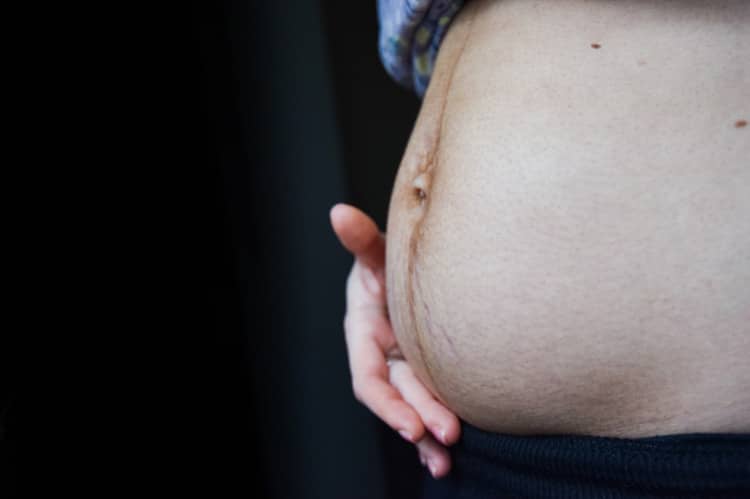
Suitable exercises for diastasis after childbirth and during pregnancy
Seeking the help of a physiotherapist is the best possible solution, however, if this is not possible under certain circumstances, you can also exercise at home. Individual exercises are suitable to be performed after childbirth and during pregnancy. Strengthening the abdominal muscles and the middle of the body during pregnancy can be a suitable prevention against the development of diastasis. Otherwise, exercises for diastasis primarily serve to eliminate it. Physiotherapy and effective exercises currently represent a proven method of solving such a condition without the need for surgical therapy.
Before you start exercising and strengthening your abdominal muscles, it is advisable to learn how to breathe properly. Diaphragmatic breathing is important, which contributes to the correct technique during exercise. It is important to take a deep breath through the nose - when you inhale, feel the belly expand. Subsequently, it is the turn of a harmonious exhalation. In this way, the abdominal muscles are under slight tension and contribute to the elimination of diastasis.
- Bridge - starts lying on the back, legs are aligned, hands freely next to the body. Subsequently, together with the diaphragm breath, the woman lifts the pelvis upwards. In the upper position, the woman lasts at least 5-10 seconds, practicing faster inhalations and exhalations. It is also appropriate to tighten the buttock muscles in the upper position (push the legs together).
- Alternate placing the heel on the ground - the basic position is lying on the back, while the legs are bent at the knees. Then, lift your heels into the air together with your inhale so that together with your thighs, they form a right angle with your stomach. The legs are still bent. He exhales when placing his heels on the ground. Do the exercise slowly. You can then try alternating legs. It is important that the linea alba comes under tension.
- Reverse Plank – Starts in a seated position with your arms behind your body and leaning on them. In the sitting position, the body is slightly tilted backwards (oblique). With a breath, lift your butt and legs and try to get into an inclined plank position. With an exhalation, relax and return to the starting position.
There are a large number of effective exercises that women can perform during pregnancy or after childbirth. Choose those that you can perform technically correctly. The primary goal is to strengthen the center of the body, which helps to eliminate diastasis or prevent its occurrence. If you are concerned that you are not doing the exercises correctly, watch the available videos or consult a physiotherapist.
If you have diastasis recti after a caesarean section, be careful and do not rush the beginning of the exercise. Follow your body's signals. The body's reactions to exercise are very individual. It is ideal to allow the body maximum time for recovery during the six-week period. Don't forget about wound healing and stitches, which ensure good tissue fusion. Disrupting them can cause further complications, so allow yourself enough time for regeneration. When to start exercising after giving birth depends on a number of factors.

Tupler's technique - exercises
In the Tupler method, a special abdominal belt is used, which is a support for the abdominal muscles. The technique is only suitable for women after childbirth. However, the abdominal belt itself is not a solution to diastasis in itself and is only an aid. Wrapping the abdomen eliminates the possibility of the abdominal muscles spreading. The tightening belt is worn during the day and is also recommended at night. Tupler's technique consists not only in exercises, but also in gentle standing up or lying down of the patient. The tightening belt is part of various exercises and breathing techniques that contribute to the elimination of diastasis. You can sit on a chair and press your back against the backrest (you can sit on the floor in Turkish sitting). Place one hand above the navel and the other below. Take a deep breath and pull your belly in while exhaling. Abdominal muscles are effectively activated during breathing and in a suitable position.
How to prevent diastasis in pregnancy?
The most important thing is for women to be aware that pregnancy is a risk factor for the development of diastasis. Spreading of the abdominal muscles during pregnancy is not unusual, and hormonal and physiological changes in the organism and the body are to blame. Prevention during pregnancy is the application of appropriate exercises to strengthen the pelvic floor and abdominal muscles. However, if a woman plans to become pregnant, it is advisable to strengthen the abdominal muscles and the center of the body even before conception. This significantly reduces the risk of developing diastasis or at least limits the occurrence of a more serious type.
Diastasis in pregnancy and after childbirth - experience
This phenomenon is nothing new for many mothers. Most often, women can diagnose diastasis by self-examination. Women recommend doing a self-examination for diastasis after six weeks. Women who had diastasis recti after childbirth often sought the help of a physiotherapist, but many also exercised at home. For some, the diastasis was corrected without exercise, others were helped by several months of active exercise. Most women agree that it takes a relatively long time to remove a diastasis after childbirth, while genetics and the condition of the abdominal ligaments also play a role.
Some women did not avoid surgery when the gap was more than 10 cm. Diastasis and another pregnancy is not a problem, but many women recommend strengthening the abdominal muscles as a preventive measure to avoid further symptoms related to the separation of the abdominal muscles. Multiple births significantly weakens the muscles in the abdominal area.
The most frequent questions - FAQ
Is diastasis after childbirth a problem for you? Do you suffer from symptoms of diastasis during pregnancy or after childbirth? What to do if diastasis occurs after caesarean section ? With diastasis of the abdominal muscles, the linea alba rectus abdominis muscle weakens and, as a result, the right and left muscle tissues separate. Most often, women encounter this phenomenon after childbirth, but also during pregnancy. The solution consists in strengthening the abdominal muscles using special exercises aimed at strengthening the center of the body. Do you have experience with diastasis ? We will be happy if you share your opinions, advice, tips and recommendations below the article in the comments. Discuss with other moms.
Is diastasis dangerous?
What does diastasis look like after childbirth?
Can diastasis be cured?
What is the difference between diastasis and abdominal muscle spacing?
Gallery
Pridať komentár

